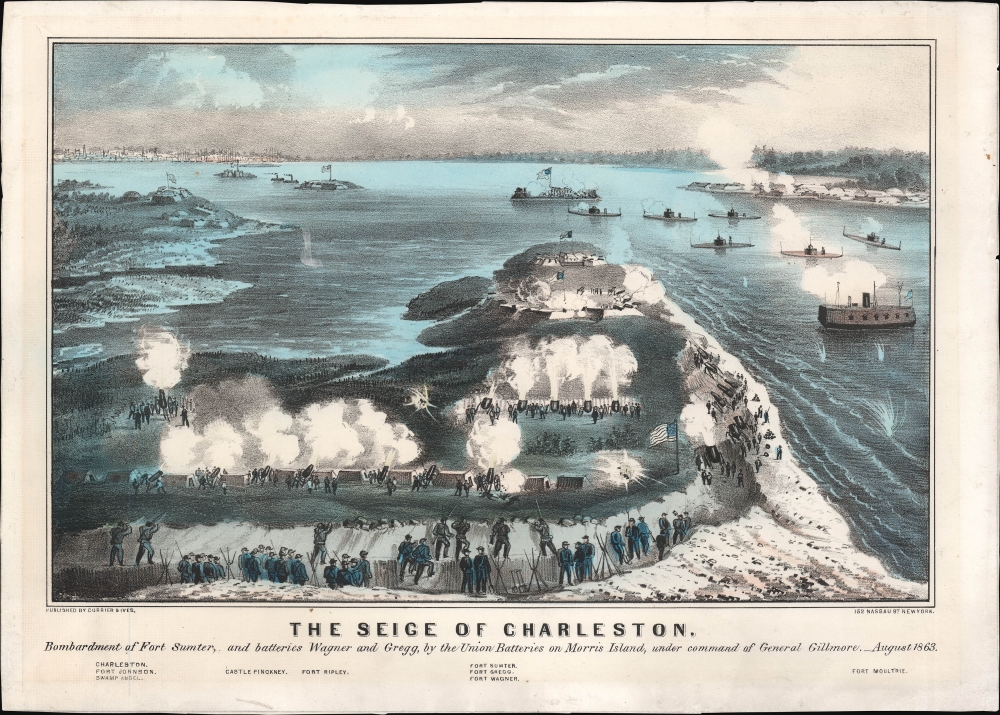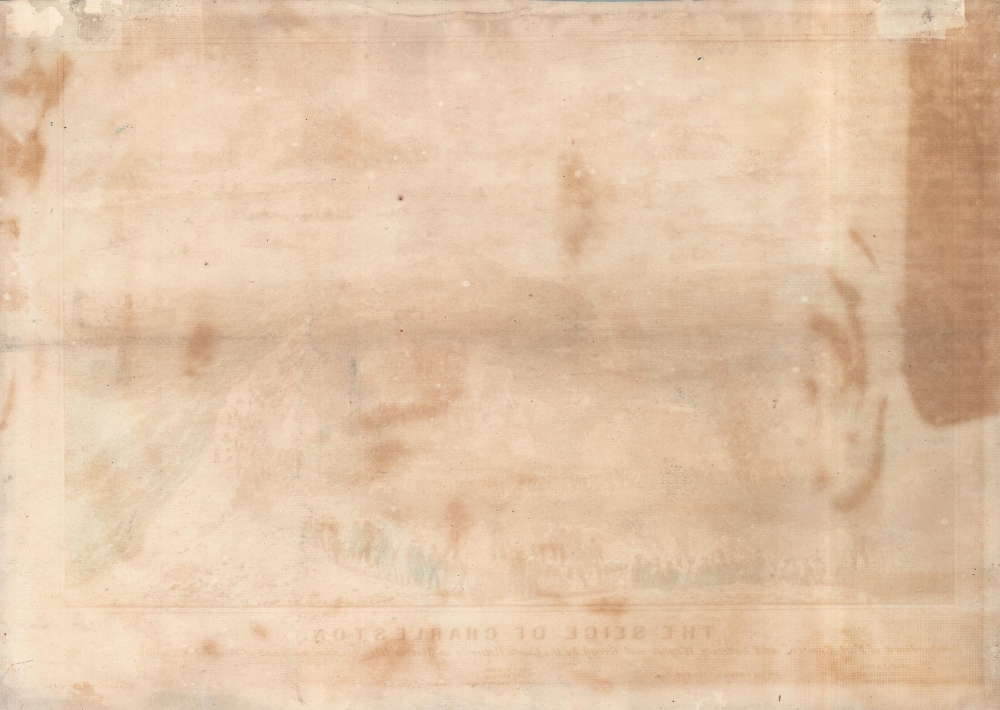This item has been sold, but you can get on the Waitlist to be notified if another example becomes available, or purchase a digital scan.
1863 Currier / Ives Print of the Siege of Charleston, U.S. Civil War
Charleston-currierives-1863
Title
1863 (undated) 8 x 12.5 in (20.32 x 31.75 cm)
Description
A Closer Look
This print, roughly oriented towards the northwest, depicts Union land and sea barrages of Confederate positions, especially at Forts Wagner and Sumter, during the Siege of Charleston, South Carolina in the summer of 1863. The approximate location of various fortifications is indicated at bottom. At this point in the siege, Union forces repeatedly tried to assault Fort Wagner at the tip of Morris Island, a costly endeavor that did eventually succeed in capturing the fort in early September. Currier and Ives' depiction provides the viewer with some sense of the intensity of the battle, including the close proximity of the opposing cannons.Siege of Charleston
Beginning in April 1863, Union forces attempted to take the forts surrounding Charleston Harbor as a precursor to taking the city itself, one of the largest and most important in the Confederacy. Doing so would have allowed the Union, which enjoyed near-total naval superiority, to open a new front on land and divide the Confederacy's already overstretched forces. Standing in their way were the imposing fortifications around the harbor, seized by the Confederates in the opening stage of the conflict and further reinforced since.The Union was unable to effectively coordinate land and naval forces. Impatience in the face of obstacles led to costly failed attempts to storm the fortifications, including a courageous but unsuccessful attack of Fort Wagner at the mouth of the harbor by the 54th Massachusetts Infantry Regiment, an African-American unit, depicted in the 1989 film Glory.
Though these Union assaults were generally unsuccessful, they did take a toll on their opponents. Both Sumter and Wagner were reduced to little more than a pile of rubble after weeks of Union barrages. Eventually, on September 6-7, feeling their position untenable, the Confederates abandoned Fort Wagner. However, a Union attack on Fort Sumter the following day was repulsed. Union forces were unable to gain significant further progress and the battle for the harbor settled into a stalemate. Charleston was not captured by the Union until February 1865, and only then due to an attack from the south and west by forces under William Tecumseh Sherman. A large fire in December 1861 had badly damaged Charleston, and the nearly two-year siege in 1863-1865 destroyed much of the rest of the city. The first Union troops to enter Charleston in February 1865 were from two 'Colored Regiments' consisting of African-American troops.
Publication History and Census
This print was published by Charles Currier and James Ives in 1863 or early 1864. Although their images of the Civil War are iconic, original Currier and Ives prints are difficult to come by. We are only able to locate institutional holdings of this print in seven libraries, museums, and research institutions in the United States.CartographerS
Charles Jacob Currier (February 8, 1819 - December 4, 1887) was an American publisher, lithographer, and engraver active in New York during the second half of the 19th century. He was born in Roxbury, Massachusetts. Currier is often overshadowed by his older brother, Nathaniel Currier, of the Currier and Ives firm. While Charles Currier is sometimes associated with Currier and Ives, and with Nathaniel Currier separately, he also published independently under his own imprint. It was Charles Currier who introduced Nathaniel Currier (1813 - 1888), to his brother-in-law James Merritt Ives (1824 - 1895), who eventually partnered in 1857 to found one of the predominate graphic publishing firms in American history, Currier and Ives. He died in Brookline, Massachusetts and is buried in Greenwood Cemetery, Brooklyn. More by this mapmaker...
James Merritt Ives (March 5, 1824 - January 3, 1895) was an American businessman, bookkeeper, and lithographer who oversaw the business side of the famed lithographic firm Currier and Ives. Born in New York City, Ives was a self-trained artist who began working at the age of twelve. He married Caroline Clark (1827 - 1896) on June 24, 1846, who was the sister-in-law of Nathaniel Currier's brother, Charles Currier. In 1852, Nathaniel Currier (March 27, 1813 - November 20, 1888) hired Ives as the bookkeeper for his firm N. Currier, Lithographer, on Charles's recommendation. Ives' talent for art and his knowledge of the artistic world soon became apparent to Currier, who valued his insights as well as the business acumen. Currier offered Ives a full partnership in 1857. They renamed the firm 'Currier and Ives' with Ives as the general manager. Ives began to play a role in selecting artists and prints to publish, and was responsible for pursuing publication of scenes of middle-class America that made the firm famous. After Ives died in 1895, his sons continued to work with Currier's son to manage the firm until it was liquidated in 1907. Learn More...




